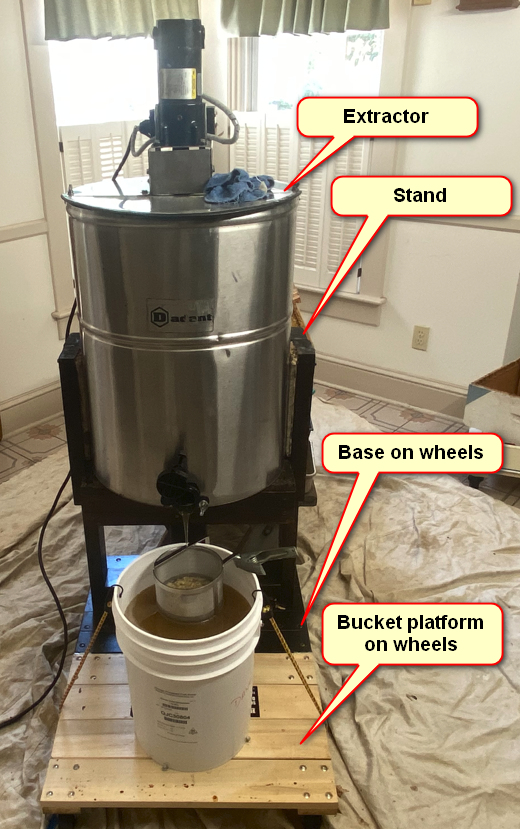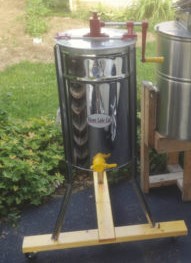
 The FCBA owns a manual extractor and an electrically-powered extractor. Extractors can be rented only by FCBA members. The manual extractor works fine for a small number of honey supers. For a large frame count, the electrically-powered extractor will save on shoulder wear-and-tear! Watch the power extractor in action.
The FCBA owns a manual extractor and an electrically-powered extractor. Extractors can be rented only by FCBA members. The manual extractor works fine for a small number of honey supers. For a large frame count, the electrically-powered extractor will save on shoulder wear-and-tear! Watch the power extractor in action.
The manual extractor is capable of extracting both deep as well as medium and shallow frames. The powered extractor can normally extract only medium and shallow frames, but Dave Maloney has a set of three metal basket inserts you can borrow if extracting deeps. You will need special instructions before using these baskets.
Cost. The cost for rental is $15 per 4-day session (pickup on day 1, use on day 2 and if need be on day 3, return on day 4 or earlier) for the powered extractor and $5 for the manual extractor (for three days). Payment should be made by check payable to FCBA. Alternatively, you can pay via PayPal. See below for payment details.
Pickup: Extractors are stored in Dave Maloney’s home at 1612 Shookstown Rd., Frederick, MD. Contact Dave (dave@maloney.com, 301-712-5855) to arrange for their use. Provide a couple optional dates for pickup. Also, let Dave know which extractor you need: manual or powered. Provide preferred pickup time as well. (BTW, 9AM for pickup time is usually good.) Return them to Dave when done.
You will need to load large items. For the power extractor, sedans will not work unless you make two trips The power extractor comes with the stand, the stand base and the bucket platform. There is also the large uncapping tub. Pickups or a vehicle having the carrying capacity of a SUV is needed. See above picture.
Cleanup. Tile extractor and push remaining honey through gate and into bucket using a spatula. Then, it you want, tilt the extractor to let residual honey run out. Once outside, hose the extractor interior down with cold water. Do NOT dismantle. Nearly all residual honey and bits of wax can be removed without dismantling the extractors. Hose down inside first with cold water. Blast the bits of wax and propolis away. Be sure to scrape wax buildup from interior frame holders. Then pour a bucket or two of hot water into the extractor to dissolve any remaining honey. Rub down the inside with a clean brush or sponge to dissolve and remove left-over honey. Then another good blast of water will leave it pretty clean.
On the powered extractor, be sure to keep the motor covered with a plastic bag during clean-up to avoid getting it wet. Wipe down exterior with warm water. When cleaning the powered extractor, be careful of the fragile plastic drain gate on the outside at the bottom edge of the extractor.
As noted, dismantling the powered extractor is not necessary. Reassembly has proven problematic in the past (parts are lost), so please clean without dismantling.
What you get: The following are provided along with either extractor:
- Extractor. If using the powered extractor, you also get a wooden extractor stand, a stand base on wheels and a bucket support platform on wheels. If using the manual extractor, you get a T-shaped base on wheels.
- Uncapping tub with wooden cross piece with frame pivot nail. Example #1. Example #2.
- Serrated manual uncapping knife
- Uncapping fork. Watch this YouTube video to learn how to properly use the uncapping fork.
- Two-part honey strainer and a 400 micron filter
- 5 gal bucket with gate and lid
- Refractometer to check honey moisture level
- Dave’s deep frame extracting baskets (optional). These baskets are only needed when using the electrically-powered extractor and then only when extracting deep frames. Not needed for the manual extractor.
What you need to get:
- Be sure to get your own 4- or 5-gallon food-safe plastic buckets with lids. Either will fit beneath the extractor honey gates. One bucket should have a honey gate to facilitate filling jars: see example. McCutcheon’s Apple Products often has empties for sale but BE SURE to compare the embossed name on the lid with the name on the bottom of the bucket. They must match or the lid probably will not fit. BTW, buckets might have either an 11″ or 12″ opening. If you intend on using the club’s 400 micron filter, note that it is designed to be used only with the larger, i.e., 12″, bucket opening.
- If using the powered extractor, you will also need to use bungee cords to hold bucket in place. Watch the power extractor in action.
- Be sure to have your own floor covering as well. A cloth painters drop cloth works well.
Use. Have your buckets ready before hand. Be sure the extractor is as evenly balanced with frames of honey as possible. It is suggested that you cover the floor with a cloth painter’s drop cloth. Have wet kitchen towels handy to keep hands and tools clean and to clean any honey or wax particles that fall to the floor.
For the electrically-powered unit, start on low speed and run for a few minutes before increasing speed. By carefully lifting the lid slightly and peering inside with a flashlight you can see when the honey has pretty much stopped being flung from the frames to the wall of the extractor. Watch FCBA member Phil Seraphinas’ tips on extracting honey.
The extractor will sometimes shake or wobble if not perfectly balanced. That is OK. The modest shaking will die down as the frames equalize their weight when spinning. Besides, the wheeled base absorbs the shaking. But excessive shaking is not OK. Stop the machine and check to see if something might be causing the imbalance. It might be that you neglected to uncap BOTH sides of one of the frames, or that a frame has jumped out of its slot.
The manual extractor comes with a T-shaped stand on casters. This stand will help absorb extractor wobbling as you crank.
Be sure to drain honey regularly. Failure to do so will result in the honey level reaching the bottom of the spinning frames and slowing the motor down.
If extracting deep frames in the electric extractor, be sure to get clear directions from Dave on the use of his baskets that are designed to hold deep frames. Improper use will damage the frames as well as the extractor. The manual extractor extracts shallow, medium as well as deep frames without the need for these baskets.
For a comprehensive review of the honey harvesting process watch this YouTube video.
Note: If this is your first time extracting, when picking up please allow 10 minutes or so for Dave to review some important issues with you.
Payment
Payment can be made by check or online.
Make checks payable to FCBA and mail to c/o Treasurer Cindy Heivilin, 2409 Doubs St., Adamstown, MD 21710 or pay via PayPal/Card below.
